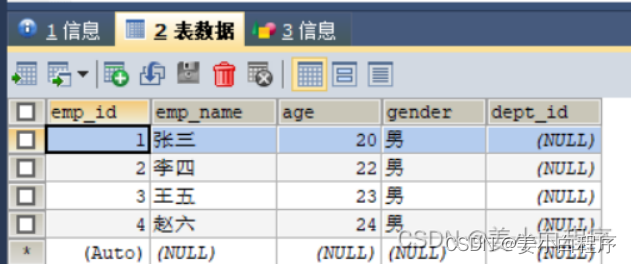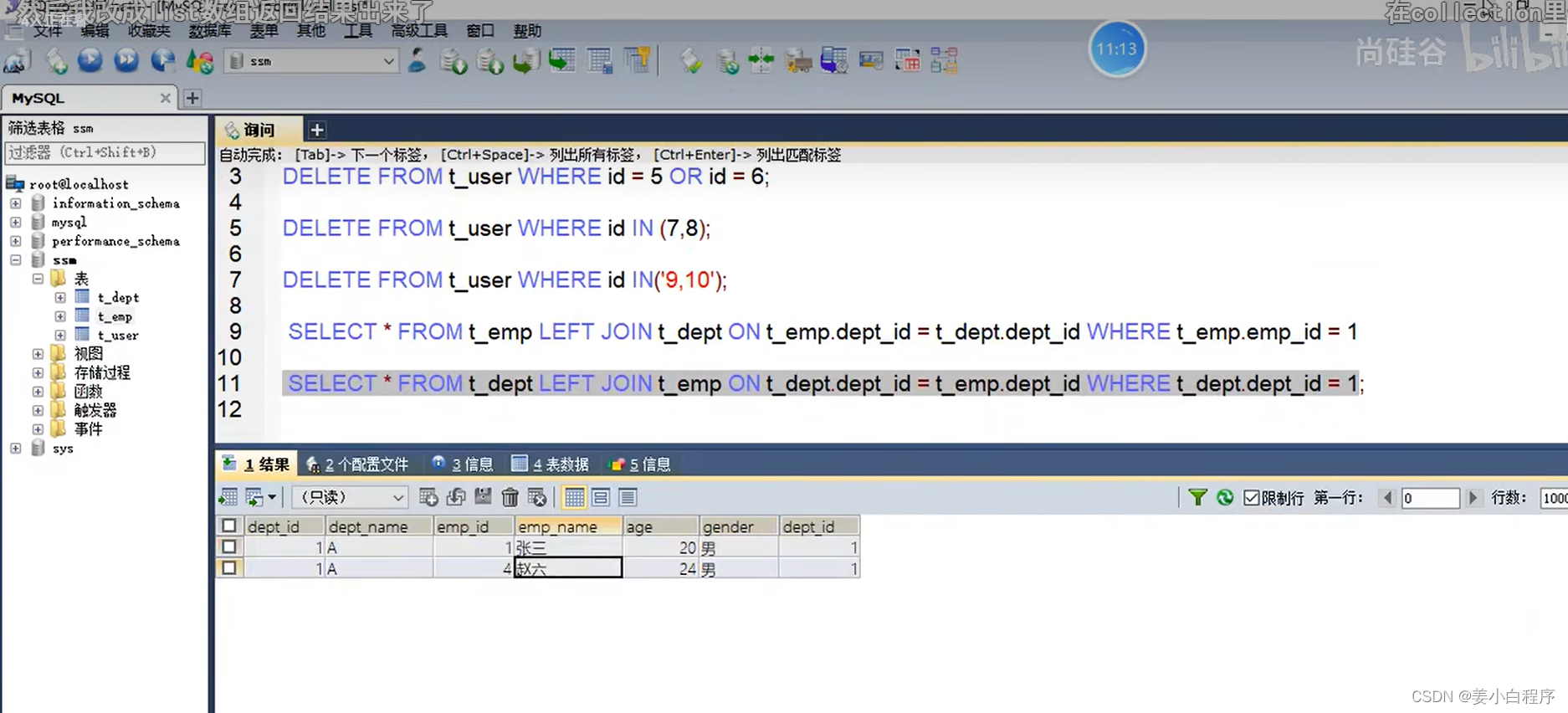一. 处理多对一映射关系功能分析(这里面如果看得不是很多明白话 可以回去在看Mysql基础 宋红康老师的Mysql)
B站硅谷宋红康老师的Mysql 或李玉婷老师的Myaql
表关系有四种:一对一 多对一 一对多 多对多
这里我们主要学习 : 多对一 和 一对多
因为一对一和多对多的处理方式是一样的
问题:表和表之间有关系 他反映射的实体之间有没有关系
比如:通过一个字段来表示当前员工所对应部门的id

在他所对应的实体类中 我们也要设置一个属性来表示员工所对应的部门的信息 应该如何设置
表对应是实体类 字段对应的是属性
表里面的一条数据对应实体类对象
如今我们员工对部门是多对一,也就是说一个员工对应一个部门信息,也就是说对应一条部门的数据
一个部门信息对应一个部门对象 如何设置实体类和实体之间的关系
因为员工对部门是多对一的关系 所以一个员工对应一个部门对象
反过来说 一个部门有多个员工信息 一个部门里面如何设置一个员工的集合
对一是一个对象
对多一个集合
例如:张三对应的是dept_id为1的信息


Emp.java
1 public class Emp {
private Integer empId;
private String empName;
private Integer age;
private String gender;
private Dept dept;
} public Dept getDept() {
return dept;
}
public void setDept(Dept dept) {
this.dept = dept;
} @Override
public String toString() {
return "Emp{" +
"empId=" + empId +
", empName='" + empName + '\'' +
", age=" + age +
", gender='" + gender + '\'' +
", dept=" + dept +
'}';
}
EmpMapper
/**
* 获取员工以及所对应的部门信息
* @param empId
* @return
*/
Emp getEmpAndDeptByEmpId(@Param("empId") Integer empId);方式一:级联
EmpMapper.xml 这个测试时为空 视频能正常运行
<resultMap id="empAndDeptResultMap" type="Emp">
<id column="emp_id" property="empId"></id>
<result column="emp_name" property="empName"></result>
<result column="age" property="age"></result>
<result column="gender" property="gender"></result>
<result column="dept_id" property="dept.deptId"></result>
<result column="dept_name" property="dept.deptName"></result>
</resultMap>
<!--Emp getEmpAndDeptByEmpId(@Param("empId") Integer empId);-->
<select id="getEmpAndDeptByEmpId" resultMap="empAndDeptResultMap">
select
t_emp.*,t_dept.*
from t_emp
left join t_dept
on t_emp.dept_id = t_dept.dept_id
where t_emp.emp_id = #{empId}
</select>正常结果应该是

不同我实际测试为null 还没找到原因

方式二: association
<resultMap id="empAndDeptResultMap" type="Emp">
<id column="emp_id" property="empId"></id>
<result column="emp_name" property="empName"></result>
<result column="age" property="age"></result>
<result column="gender" property="gender"></result>
<!--
association:处理多对一的映射关系(处理实体类类型的属性)
property:设置需要处理映射关系的属性的属性名
javaType:设置要处理的属性的类型
-->
<association property="dept" javaType="Dept">
<id column="dept_id" property="deptId"></id>
<result column="dept_name" property="deptName"></result>
</association>
</resultMap>测试和第一种方式一样 我找不到 视频能查到
第三种方式 分步查询
EmpMapper
/**
* 通过分步查询查询员工以及所对应的部门信息的第一步
* @param empId
* @return
*/
Emp getEmpAndDeptByStepOne(@Param("empId") Integer empId);EmpMapper.xml
<resultMap id="empAndDeptByStepResultMap" type="Emp">
<id column="emp_id" property="empId"></id>
<result column="emp_name" property="empName"></result>
<result column="age" property="age"></result>
<result column="gender" property="gender"></result>
<association property="dept"
select="com.atguigu.mybatis.mapper.DeptMapper.getEmpAndDeptByStepTwo"
column="dept_id"></association>
</resultMap>
<!--Emp getEmpAndDeptByStepOne(@Param("empId") Integer empId);-->
<select id="getEmpAndDeptByStepOne" resultMap="empAndDeptByStepResultMap">
select * from t_emp where emp_id = #{empId}
</select>DeptMapper.xml
<!--Dept getEmpAndDeptByStepTwo(@Param("deptId") Integer deptId);-->
<select id="getEmpAndDeptByStepTwo" resultType="Dept">
select * from t_dept where dept_id = #{deptId}
</select>测试:ResultMapTest
@Test
public void testGetEmpAndDeptByStep(){
SqlSession sqlSession = SqlSessionUtil.getSqlSession();
EmpMapper mapper = sqlSession.getMapper(EmpMapper.class);
Emp emp = mapper.getEmpAndDeptByStepOne(1);
System.out.println(emp);
} @Test
public void testGetEmpAndDeptByStep(){
SqlSession sqlSession = SqlSessionUtil.getSqlSession();
EmpMapper mapper = sqlSession.getMapper(EmpMapper.class);
Emp emp = mapper.getEmpAndDeptByStepOne(2);
System.out.println(emp);
}
<!--
property:设置需要处理映射关系的属性的属性名
select:设置分步查询的sql的唯一标识
column:将查询出的某个字段作为分步查询的sql的条件
-->
分步查询的优势:
分步查询的优点:可以实现延迟加载 也叫懒加载但是必须在核心配置文件中设置全局配置信息:lazyLoadingEnabled :延迟加载的全局开关。当开启时,所有关联对象都会延迟加载aggressiveLazyLoading :当开启时,任何方法的调用都会加载该对象的所有属性。否则,每个属性会按需加载此时就可以实现按需加载,获取的数据是什么,就只会执行相应的 sql 。此时可通过 association 和collection 中的 fetchType 属性设置当前的分步查询是否使用延迟加载, fetchType="lazy( 延迟加载 )|eager( 立即加载 )"
<settings>
<!--将下划线映射为驼峰-->
<setting name="mapUnderscoreToCamelCase" value="true"/>
<!--开启延迟加载-->
<setting name="lazyLoadingEnabled" value="true"/>
<!--按需加载-->
<setting name="aggressiveLazyLoading" value="false"/>
</settings>ResultMapTest
@Test
public void testGetEmpAndDeptByStep(){
SqlSession sqlSession = SqlSessionUtil.getSqlSession();
EmpMapper mapper = sqlSession.getMapper(EmpMapper.class);
Emp emp = mapper.getEmpAndDeptByStepOne(2);
System.out.println(emp.getEmpName());
}只执行了一个员工的SQL

fetchType="eager" 使用
<resultMap id="empAndDeptByStepResultMap" type="Emp">
<id column="emp_id" property="empId"></id>
<result column="emp_name" property="empName"></result>
<result column="age" property="age"></result>
<result column="gender" property="gender"></result>
<!--
property:设置需要处理映射关系的属性的属性名
select:设置分步查询的sql的唯一标识
column:将查询出的某个字段作为分步查询的sql的条件
fetchType:在开启了延迟加载的环境中,通过该属性设置当前的分步查询是否使用延迟加载
fetchType="eager(立即加载)|lazy(延迟加载)"
-->
<association property="dept" fetchType="eager"
select="com.atguigu.mybatis.mapper.DeptMapper.getEmpAndDeptByStepTwo"
column="dept_id"></association>
</resultMap>
<!--Emp getEmpAndDeptByStepOne(@Param("empId") Integer empId);-->
<select id="getEmpAndDeptByStepOne" resultMap="empAndDeptByStepResultMap">
select * from t_emp where emp_id = #{empId}
</select>
<!--
property:设置需要处理映射关系的属性的属性名
select:设置分步查询的sql的唯一标识
column:将查询出的某个字段作为分步查询的sql的条件
fetchType:在开启了延迟加载的环境中,通过该属性设置当前的分步查询是否使用延迟加载
fetchType="eager(立即加载)|lazy(延迟加载)"
-->
二. 处理一对多映射关系功能分析(这里面如果看得不是很多明白话 可以回去在看Mysql基础 宋红康老师的Mysql)
1 . 通过collection处理一对多的映射关系
实体类 Dept
public class Dept {
private Integer deptId;
private String deptName;
private List<Emp> emps;
}get/set 重写toString
需求:查询部门信息 并把部门中所有的员工查询出来
DeptMapper
/**
* 查询部门以及部门中的员工信息
* @param deptId
* @return
*/
Dept getDeptAndEmpByDeptId(@Param("deptId") Integer deptId);方式一:通过collection处理一对多的映射关系
DeptMapper
<resultMap id="deptAndEmpResultMap" type="Dept">
<id column="dept_id" property="deptId"></id>
<result column="dept_name" property="deptName"></result>
<!--
ofType:设置集合类型的属性中存储的数据的类型
-->
<collection property="emps" ofType="Emp">
<id column="emp_id" property="empId"></id>
<result column="emp_name" property="empName"></result>
<result column="age" property="age"></result>
<result column="gender" property="gender"></result>
</collection>
</resultMap>
<!--Dept getDeptAndEmpByDeptId(@Param("deptId") Integer deptId);-->
<select id="getDeptAndEmpByDeptId" resultMap="deptAndEmpResultMap">
SELECT *
FROM t_dept
LEFT JOIN t_emp
ON t_dept.dept_id = t_emp.dept_id
WHERE t_dept.dept_id = #{deptId}
</select>测试: ResultMapTest
@Test
public void testGetDeptAndEmpByDeptId(){
SqlSession sqlSession = SqlSessionUtil.getSqlSession();
DeptMapper mapper = sqlSession.getMapper(DeptMapper.class);
Dept dept = mapper.getDeptAndEmpByDeptId(1);
System.out.println(dept);
}
2 . 通过分步查询处理一对多的映射关系
DeptMapper
/**
* 通过分步查询查询部门以及部门中的员工信息的第一步
* @param deptId
* @return
*/
Dept getDeptAndEmpByStepOne(@Param("deptId") Integer deptId);方式二:通过分步查询处理一对多的映射关系
DeptMapper.xml
<resultMap id="deptAndEmpResultMapByStep" type="Dept">
<id column="dept_id" property="deptId"></id>
<result column="dept_name" property="deptName"></result>
<collection property="emps"
select="com.atguigu.mybatis.mapper.EmpMapper.getDeptAndEmpByStepTwo"
column="dept_id"></collection>
</resultMap>
<!--Dept getDeptAndEmpByStepOne(@Param("deptId") Integer deptId);-->
<select id="getDeptAndEmpByStepOne" resultMap="deptAndEmpResultMapByStep">
select * from t_dept where dept_id = #{deptId}
</select>EmpMapper
/**
* 通过分步查询查询部门以及部门中的员工信息的第二步
* @param deptId
* @return
*/
List<Emp> getDeptAndEmpByStepTwo(@Param("deptId") Integer deptId);EmpMapper.xml
<!--List<Emp> getDeptAndEmpByStepTwo(@Param("deptId") Integer deptId);-->
<select id="getDeptAndEmpByStepTwo" resultType="Emp">
select * from t_emp where dept_id = #{deptId}
</select>测试:
@Test
public void testGetDeptAndEmpByStep(){
SqlSession sqlSession = SqlSessionUtil.getSqlSession();
DeptMapper mapper = sqlSession.getMapper(DeptMapper.class);
Dept dept = mapper.getDeptAndEmpByStepOne(1);
System.out.println(dept);
}
@Test
public void testGetDeptAndEmpByStep(){
SqlSession sqlSession = SqlSessionUtil.getSqlSession();
DeptMapper mapper = sqlSession.getMapper(DeptMapper.class);
Dept dept = mapper.getDeptAndEmpByStepOne(1);
System.out.println(dept.getDeptName());
}
这部分的内容 听得比较不清楚 所以笔记做的比较乱 大家不要去操作 这篇笔记只做为个人学习笔记





















 5257
5257











 被折叠的 条评论
为什么被折叠?
被折叠的 条评论
为什么被折叠?








